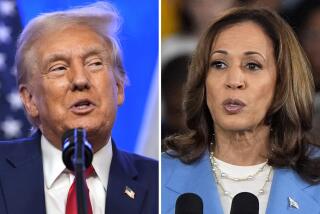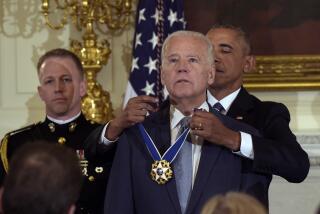Obama steps forward with his own plan
WASHINGTON — With a series of forceful actions in recent days, amid an almost unprecedented set of challenges, Barack Obama has taken an unusual step for a president-elect: attempting to alter the country’s perilous course even before he takes office.
The most dramatic example came Saturday, when Obama announced a far more aggressive economic stimulus plan than previously promised -- a two-year program to add 2.5 million jobs that he said represented “an early down payment on the type of reform my administration will bring to Washington.”
That announcement was the latest indication that the president-elect has decided to use the transition period to influence events at a time of crisis, when the current administration appears powerless to stop a slide.
“There’s no question that Bush is still president, but people are looking for signs to see what’s going to happen going forward,” said an Obama aide who, like others, requested anonymity when discussing deliberations inside the transition. “We’re going to attempt to do that in this period.”
Obama has moved with unusual speed to fill most of his top White House staff positions. And over the last week, he settled on a number of key Cabinet appointments designed to remove the uncertainty that has sparked turbulence in the financial markets and to replace it with a sense of confidence in the administration-in-waiting. He offered the all-important job of Treasury secretary to a pragmatic and experienced regulator, Timothy F. Geithner, and reached out to former campaign rival Hillary Rodham Clinton, an experienced figure known around the world, to be the country’s top diplomat. After the Geithner selection was reported Friday, the Dow Jones industrial average soared nearly 500 points.
On Monday, the president-elect will emerge from two weeks of near-seclusion to stand shoulder-to-shoulder with his economics team for a news conference that aides hope will help calm an anxious public.
Obama’s aggressive posture marks an evolution inside his transition team since immediately after the Nov. 4 election, when he pledged to live by a mantra that the country is led by “one president at a time.”
Obama and his aides have been discussing how hands-off he should be with circumstances changing so dramatically: stocks tumbling; negotiations stalling over an economic stimulus plan and a possible automobile industry bailout; and another financial giant, Citigroup Inc., at risk.
The quandary for Obama’s team has been how to finesse a set of challenges not seen since 1932: a quickly deteriorating economy and a transition of power between two presidents with vastly different views on how to fix it.
“They recognize it’s a careful balancing act, because you want to bring a whole new face to it when you’re in office,” said Leon Panetta, a White House chief of staff under President Clinton who has informally advised Obama’s aides and has had recent conversations with them. “But at the same time, there’s an underlying concern that things seem to be deteriorating rapidly” -- making the new president’s job harder.
Panetta said the country is “caught between a president who doesn’t have a lot of credibility even if he tries to do something and a new president who, if it looks like he’s going to lay out things he’s going to try to do, it looks like he’s putting the cart before the horse. It’s a tough place for the country to be in right now.”
Aides are wary too of taking ownership of problems they do not yet have the formal power to address.
Still, with the financial markets and the public clearly looking for reassurance, Saturday’s announcement -- and Monday’s news conference -- signal that the transition has entered a phase in which the president-elect will become more visible and vocal.
Obama has yet to stake a firm position on the auto bailout being discussed on Capitol Hill, but he might inject himself into the debate as he takes questions Monday on the country’s economic woes.
The balancing act was apparent last week as Obama worked behind the scenes to settle on a series of gravitas-heavy Cabinet appointments and looked for creative ways to signal policy changes.
He made no live public appearances. But he used a videotaped message to a bipartisan meeting of governors to promise quick action on limiting greenhouse gas emissions and enacting a controversial plan to charge companies for the right to emit gases that cause global warming.
Some opponents of a “cap and trade” program have said it could further hurt the economy by adding costs for companies. Obama’s address suggested he viewed the plan as, rather, a tool to create jobs -- arguing that revenue from emissions charges would be invested in environmentally friendly industries.
Moreover, as he pursues the greenhouse gas limits, Obama stands to benefit from the victory last week by Rep. Henry A. Waxman (D-Beverly Hills) for leadership of the House Energy and Commerce Committee. Waxman ousted longtime Chairman John D. Dingell (D-Mich.), who had been viewed as an obstacle to efforts to fight global warming.
Obama did not involve himself directly in the Waxman-Dingell bout, but it was widely believed that the president-elect had a clear favorite -- particularly given that his newly hired legislative liaison is Waxman’s longtime chief of staff, Phil Schiliro.
In another videotaped message last week -- to European officials, endorsing a bid by his hometown of Chicago to host the 2016 Summer Olympics -- Obama sent a broad signal about changing U.S. foreign policy. “In the coming years, my administration will bring a fresh perspective on America’s role and responsibilities around the world,” Obama said.
That is likely to be the message when Obama in the coming days officially announces Clinton’s appointment as secretary of State and lays out the rest of his national security team.
Monday’s news conference will mark his first full exchange with reporters since Nov. 7, when he took questions for about 20 minutes in a session most notable for his discussion of what type of dog to get for his daughters.
This time the need for more detail and substance is greater -- as Obama seemed to acknowledge in his Saturday address, discussing his proposal to infuse the economy with money through a major program to build roads, bridges and other infrastructure.
“The news this week has only reinforced the fact that we are facing an economic crisis of historic proportions,” he said. “We now risk falling into a deflationary spiral that could increase our massive debt even further.”
Panetta said he hoped that Obama would use public appearances to introduce his Cabinet officials and key advisors and to explain why each was chosen. “He’s got to take advantage of at least some public interviews to convey to the American people a sense of hope that things are going to be OK,” Panetta said.
Experts said that, so far, Obama seemed to be heeding lessons from past presidents’ mistakes.
Historians have pointed to parallels between this year and the 1932 transition from Republican President Hoover to Democratic President Franklin D. Roosevelt. Historians believe the country’s economy was further hampered by Roosevelt’s refusal to cooperate with Hoover’s administration on strategies to help cure a deepening depression.
And in 1992, newly elected President Clinton waited too long to hire his top White House staff and moved too quickly and sloppily to begin hiring Cabinet officials, according to his aides. The result was that Clinton relied too heavily on campaign advisors to build a government, aides said.
Obama, in contrast, has named most of his top staff aides -- including veterans from that Clinton White House -- and is working with those staffers to help build out the rest of the administration. His chief of staff, Rahm Emanuel, a Chicago congressman and former Clinton aide, is considered an expert in policy and the politics of Capitol Hill.
“What Obama has done is to build the circle around him responsible for managing the decision-making, and now he is working from there,” said Terry Sullivan, an associate professor of political science at the University of North Carolina at Chapel Hill and a member of a consortium of scholars who study White House transitions. “I don’t know whether he is sending signals that he is ready to govern, or that he’s just becoming ready to govern.”
Obama also has set the scene for quick action on policies that might stem public anxiety.
On healthcare, he will rely on two people: his Health and Human Services chief, former Senate Majority Leader Tom Daschle, a master of the legislative process; and his new budget director, Peter Orszag, a healthcare policy expert with credibility on both sides of the debate over how to make insurance more affordable.
On immigration, an issue viewed by business groups as a key economic concern because of their need for foreign laborers, Obama can rely on his likely choice for Homeland Security secretary, Arizona Gov. Janet Napolitano, known for pragmatic views on the issue and support for tough border enforcement.
“These are not political flacks,” said Robert Reich, a Labor secretary in the Clinton administration.
Panetta credits Obama for sending strong signals in a time of crisis, but he adds that nothing in the transition matters as much as the messages when he is actually the president.
“The ultimate test of whether we can change is whether he can govern,” Panetta said. “We won’t know that until he walks into the Oval Office and makes the decisions that tell us who he really is.”
--
More to Read
Get the L.A. Times Politics newsletter
Deeply reported insights into legislation, politics and policy from Sacramento, Washington and beyond. In your inbox three times per week.
You may occasionally receive promotional content from the Los Angeles Times.










